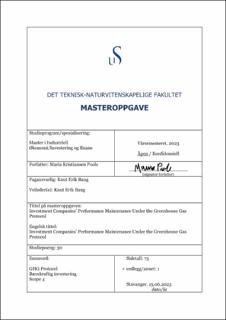| dc.description.abstract | The amount of anthropogenic greenhouse gas emissions has seen a substantial increase the past decades resulting in record-high CO2-levels in the atmosphere. In an effort to reduce emissions, several organizations established guidelines to achieve net zero emissions by 2050. The World Resources Institute and the World Business Council for Sustainable Development established The Greenhouse Gas Protocol in 1998, which required every participating company to report direct and indirect emissions. Its goal is to reach net zero emissions by 2050, and it rapidly became one of the most adopted protocols in the world.
Due to its global significance, it was desired to analyse the impact the Protocol has had on investment companies. In this thesis, we looked at certain investment companies whose primary source of income has been the oil and gas industry. These investment companies need to refocus their investment strategy to meet the emission targets. In this thesis, the following research question was derived:
“How can investment companies adhere to the Greenhouse Gas Protocol while maintaining their profit and risk profiles?”
Three focus questions were analysed to further reveal what options the investment companies have. Their potential for future performance through the methods described in the Protocol was discussed, as well as new methods highlighted in this study. In addition, the Protocol was put into question to whether it will suffice in order to meet net zero emissions by 2050. The results were based on qualitative measures conducted through interviews with three investment companies and presented with the support of a quantitative overlay.
The study highlighted the importance for the investment companies to reduce emissions, and how these positive effects will be significant for their reputation and competitive advantage. However, the guidelines in the Protocol cannot predict profit and risk profiles due to its lack of future forecasting. In this study, a new method of reporting gives the possibility of making predictions by its ability to forecast future outcomes. The significance of this, is how it potentially can increase investment companies’ profitability. In conclusion, maintaining profit and risk profiles while adhering to the Greenhouse Gas Protocol is possible through new methods of reporting. | |
